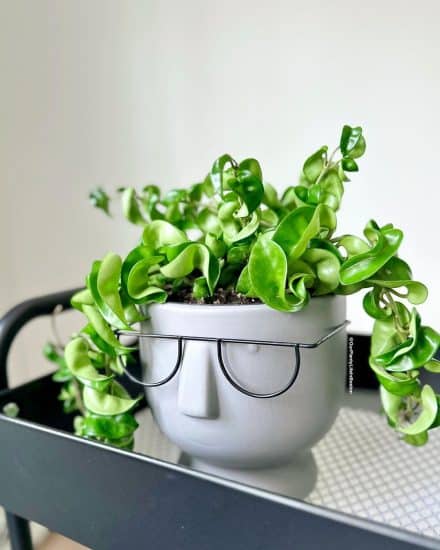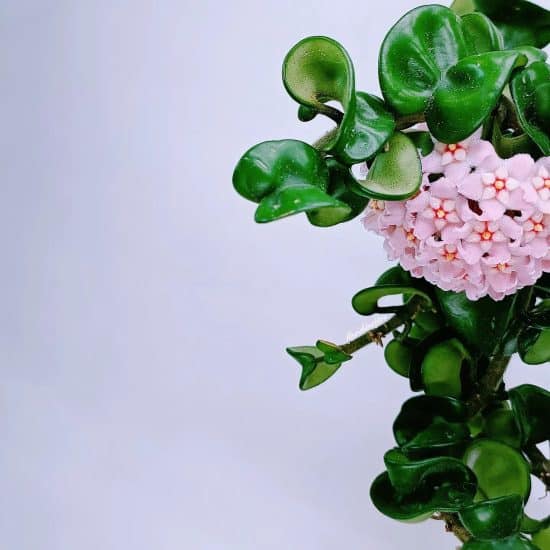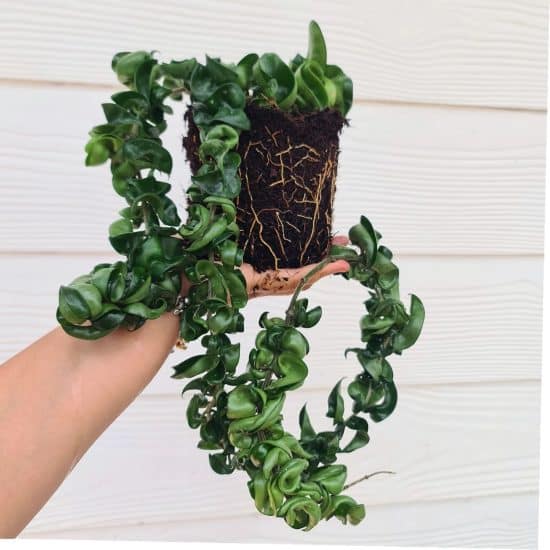The Hindu rope hoya, or Hoya carnosa ‘Compacta,’ is the kind of houseplant that makes you do a double-take. With its captivating twisted foliage and fragrant, star-shaped flowers, it’s almost hard to believe that it comes from this planet!
The Hindu rope hoya is a cultivar of Hoya carnosa, often called the wax plant, which has numerous unique cultivars to delight and confuse you when you dive down the hoya rabbit hole. Hoya carnosa ‘Compacta’ and its variegated sister are best known for their twisted, rope-like foliage, in contrast to the flatter leaves of other hoya varieties.
In this article, we’ll dive into the rabbit hole with you and explore the wonderfully whimsical world of Hindu rope hoya care. From its unique appearance to its special care requirements, you’ll learn the ins and outs of keeping this twisted (in a good way!) houseplant happy and healthy.
Table of Contents
Hoya Hindu Rope Plant Care Guide
History, Habitat, and Characteristics

The Hindu rope plant (Hoya carnosa ‘Compacta’ & ‘Krinkle Kurl’), originating from Eastern Asia and Australia, has become a beloved houseplant known for its low maintenance, unique growth patterns, and intriguing flowers.
Hindu rope plant is a slow-growing houseplant, but its popularity is anything but. Plant collectors love this plant’s compact, waxy foliage that grows in its namesake rope-like pattern. This twisting and turning creates an enchanting visual effect that sets it apart from other Hoya species.
When it’s in its happy place, the Hindu rope hoya rewards you with waxy flowers arranged in spheric clusters. With their pink hues and delightful chocolate scent, these blooms are worth waiting for.
Varieties

Hoya carnosa is the mother plant the Hindu rope plant cultivar hails from. In addition to ‘Compacta,’ Hoya carnosa has many cultivars, each with its own charm.
Here are a few related Hoya carnosa varieties:
Hoya carnosa ‘Tricolor’ features a trio of vibrant colors. Its thick, waxy leaves boast shades of dark green, creamy white, and soft pink, creating a striking visual contrast. As the plant matures, the pink hues may intensify, providing an eye-catching display. Its trailing vines and (often) heart-shaped leaves add a touch of whimsy.
Hoya carnosa ‘Compacta Regalis’ features variegation on the outside of the leaves. Unlike other hoya varieties, it grows in the same compact, structured manner of the unvariegated rope plant, making it an excellent choice for smaller spaces.
Hoya carnosa ‘Krimson Queen’ is known for its elongated, oval-shaped leaves and lovely cream-to-white variegation along the leaf margins. This contrast provides an elegant look as the pink-tinged tendrils gracefully cascade over the edges of a pot or hanging basket.
Hoya carnosa ‘Variegata’ is marked by beautifully variegated leaves featuring a mix of green and creamy white colors. The leaves are often irregularly shaped, adding to the plant’s visual interest. With a more random variegation pattern, this variety truly stands out.
Light

You shouldn’t have too much trouble striking the perfect balance of light for your Hindu rope plant. This houseplant thrives in bright indirect sunlight and even appreciates a touch of direct sun.
Since the Hindu rope plant adores sunlight, a south-facing window is prime real estate for soaking up the most light throughout the day. Just be mindful of the intensity. Too much direct sun can be a scorcher (literally). If you think your hoya rope plant is getting too much harsh afternoon sun, move it to a slightly less sunny spot.
However, if your Hindu rope plant’s leaves turn yellow, it might be craving more light. Insufficient light conditions can also result in leaves falling off. If you’re short of bright windows, you can always try adding an artificial grow light for a few hours each day.
Our lighting tips:
- A south-facing window reigns supreme for providing ample bright, diffuse light throughout the day.
- Protect Hindu rope plants from too much direct sun, especially in the early afternoon.
- Don’t hesitate to use grow lights if natural light is playing hide-and-seek with your hoya rope plants.
Water

Remember, hoyas (porcelain flower) are technically succulents. They store water in their fleshy leaves and stems, so they don’t need frequent watering and are easy to overwater. Water thoroughly when the top few inches of soil have dried out, being sure to let the water flow from the drainage holes.
Overwatering can be detrimental to these plants, since they’re vulnerable to rot. To avoid this, let the soil dry out between waterings, and don’t let your plant sit in standing water. Encourage flowers by drying out the plant more than usual before giving it another thorough watering. Repeat this process a few times for the best results.
Keep an eye on your hoya rope plant’s foliage to tell if you’re underwatering. The leaves can be your guide to its hydration needs. When the leaves of your hoya rope plant become soft and slightly wrinkled, it’s a sign that your plant is craving a drink. Let the soil dry out a bit, but don’t let it become bone dry or hard to the touch.
Our watering tips:
- Allow the top few inches of soil to dry out before watering a hoya rope plant.
- Water thoroughly until water flows from the drainage holes.
- Soft and wrinkled leaves signal a need for more frequent watering.
Temperature and humidity

The hoya rope plant prefers warm temperatures within a 65-80°F (18-27°C) range. Remember, it’s a tropical plant, so it won’t like cold conditions.
While it can be flexible, be mindful of drastic temperature changes. Shield it from cold drafts (especially near windows and doors during winter), and keep an eye on the plant for any signs of wilting or drooping due to extremely high or low temperatures.
The Hindu rope plant adores a humid environment. Aim for that sweet spot of 40%-60% household humidity to keep this plant satisfied. Are the leaves drooping or turning brown at the tips? That might be a sign of too little humidity.
To increase humidity: Place your plant on the drip tray filled with pebbles or water. As the water evaporates, the plant will absorb the local humidity. For hoyas in hanging baskets, run a humidifier nearby and group with other plants to take advantage of transpiration.
Soil and planting

Hoya rope plant can handle various potting media, so crafting the ideal soil composition is a piece of cake. Aim for a well-drained mix that ticks all the right boxes for moisture levels. Combine equal parts potting medium, perlite or pumice, and orchid bark.
Hoya rope plant likes to be root-bound, so don’t go repotting it on a whim. If it’s been a couple of years and your rope plant starts to look iffy, carefully lift the plant from its pot. If the roots have begun to wrap around the outside of the soil, it’s time to replant. Gently transfer your plant to a slightly larger pot with adequate drainage holes, and just go one or two sizes up.

Your Hindu rope plant probably won’t need fertilizing because it’s a naturally slow grower. This means that it won’t take up the nutrients as fast as other plants and fertilizing could lead to a buildup of fertilizer in the soil. This could actually harm your plant, so be careful.
If you do fertilize, do so sparingly and only during the growing season. Be watchful for signs of too much fertilizer, like leaf burn or sad-looking roots. If you suspect you’ve given it too much, give the soil a good flush with water and adjust your feeding accordingly.
Propagation
With just a few simple steps, you can create new plants from your existing Hindu rope plant. We prefer the stem cutting method.
Propagating Hindu rope plant via stem cuttings:
- Snip a stem cutting. Make sure the stem has at least 3-4 leaves, and cut a 4-6 inch section just below a leaf node using clean, sharp pruning shears or scissors.
- Remove the bottom leaves. Gently pull off the bottom 1-2 leaves from your cutting, keeping the top 2-3 leaves in place. This step exposes more stem surface for rooting and helps to avoid rotting leaves in a water or soil medium.
- Place in potting mix or water. Rooting in potting mix can cut out a step, but rooting in water can help you keep an eye on your cutting’s progress (you can see those roots!). If you choose water, be sure to keep it clean and change it out every few days. If you choose soil, be sure to include enough pumice or perlite in your mixture to keep it well-draining.
- Plant that cutting. When your cutting has rooted, grab a small pot and fill it with your chosen potting mix. Create a small hole in the center, then insert the cutting with the roots submerged in the soil. Gently pat the soil around the cutting to keep it steady and secure.
- Care is key. Keep your newly potted cutting in a cozy, well-lit spot with indirect sunlight. Water the soil just enough to keep it moist but not soggy.
Common Issues

As succulent-like plants, Hoya carnosa Compacta plants are generally low-maintenance, but even the most attentive plant parent may encounter some common issues. Let’s learn how to identify and then fix them.
Yellow Leaves
When you notice yellow leaves on your hoya rope plant, it might be due to low light or overwatering. If it’s the lower leaves that are turning yellow and possibly falling off, the problem is likely insufficient light.
To fix this, move your Hindu rope plant to a brighter spot. A south-facing window is ideal, but you can add artificial lights (we recommend LED full-spectrum) if that’s not possible.
Yellow leaves can also signal overwatering, which puts your rope plant at risk for rot. To prevent this, let the soil dry out between waterings and ensure your pot has proper drainage holes — soggy soil is never a good idea.
Slow Growth
While hoya plants, including Hindu rope plants, are naturally slow growers, unusually slow growth might be an indication that your plant isn’t receiving enough light. To get your hoya plant back on track, double-check its lighting situation and make adjustments as necessary.
Place it near a bright, south-facing window or use grow lights.
Also, avoid over-fertilizing your hoya, which can do more harm than good. Instead, use a diluted liquid fertilizer and feed your plant every 4-6 weeks during its active growing period. Remember that older plants tend to grow at a slower pace than younger ones, so be patient.
Pests and Diseases
Hoya Hindu rope plants are known for their resilience, but even these charming indoor plants can encounter some common pests and diseases.
Root Rot
This can happen when the soil around your Hindu rope plant stays wet for too long, causing the roots to decay. To prevent this, use a well-draining potting mix and make sure the soil is completely dry before watering again. And, of course, make sure the pot has adequate drainage holes.
If you think your Hoya might be suffering from root rot, look for signs like wilting leaves, yellowing foliage, and a foul smell coming from the pot. If you find any of these symptoms, it’s time to take action.
Start by removing your plant from its pot and cutting off any black, slimy, or mushy roots. Then, repot your Hindu rope plant in fresh, well-drained potting mix, and be extra careful not to overwater in the future.
Mealybugs
These little troublemakers show up as dense clusters of cotton-like substance on leaves and stems, feasting on your plant’s sap and causing damage.
If you do spot mealybugs on your hoya rope plant, tackle the infestation head-on. Start by picking off or spraying the bugs with water to remove them. After that, apply a solution of dish soap and water or use neem oil to treat the affected areas. Be thorough and cover both sides of the leaves, repeating the treatment as needed.
Pro tip: For hard-to-reach places, a Q-tip or cotton swab will be your best friend.
To keep mealybugs at bay, inspect your plant regularly and keep it clean by giving it a gentle shower during watering. This has the added benefit of keeping dust out of your rope plant’s fancy crevices.
Conclusion

That’s it for our Hindu rope plant care and growing guide! With its twisted, rope-like leaves and fragrant, star-shaped flowers, this enchanting houseplant is an excellent addition to any indoor garden.
Whether you call it a wax plant, Hindu rope plant, porcelain flower, or just . . . My Precious, we hope you feel well-equipped to welcome this stunner into your home.
Hindu rope plant care summary:
- Provide bright, indirect light with a touch of direct sunlight.
- Allow the soil to dry out between waterings and avoid overwatering.
- Maintain a temperature between 65-80°F (18-27°C) and 40-60% humidity.
- Use well-draining soil and repot only when necessary.
We hope our guide has inspired you to add Hindu rope plant to your indoor garden. If you have any additional questions or concerns, don’t hesitate to reach out to us.
And if you found this guide helpful, be sure to share it with fellow plant lovers!
FAQ
Is Hoya Hindu rope a succulent?
Hoya Hindu rope plant is considered a semi-succulent. This fascinating plant’s thick, twisted leaves store water, giving it the ability to withstand periods of drought. While its appearance might differ from the typical image of succulents, its water-storing capabilities and hardiness certainly place it within the semi-succulent category.
How often does a Hindu rope bloom?
Blooms can come once or twice a year, often in the warmer months. However, bear in mind that the Hindu rope’s flowering can be unpredictable, so patience is key.
Mature plants are more likely than young ones to produce blossoms, but there’s no set rule. Some plants might surprise you with more frequent blooms, while others are more secretive with their floral displays.
What can you do to encourage flowering?
To coax your Hindu rope plant into revealing its lovely flowers, there are a few strategies to employ. First, ensure it receives enough bright, indirect light. Next, really allow the soil to dry out between waterings. Lastly, let it stay root-bound. As an epiphyte, hoyas don’t need a ton of soil around their roots.
Is the Hoya rope plant slow growing?
Yes, it’s a slow-growing plant, but with proper care and optimal conditions, it can pick up speed. Factors such as lighting, water, humidity, and overall care can greatly impact the plant’s growth rate.


